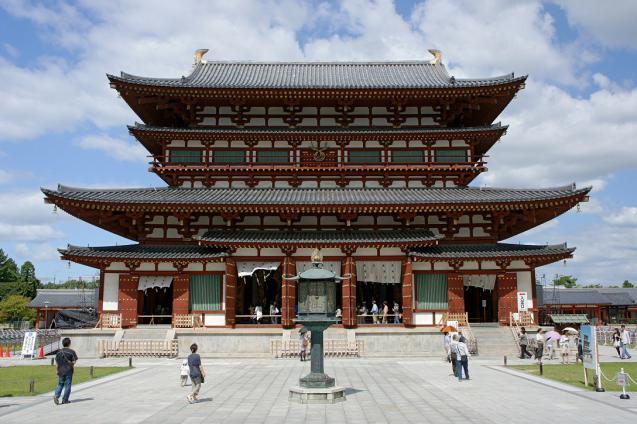
Yakushiji Temple was constructed by Emperor Tenmu in the late 7th century to pray for the recovery of his wife from a serious illness. However, the construction was not completed before the emperor's death, but it was the empress who completed the construction in 689. This temple is one of the famous imperial and ancient Buddhist temples in Japan, one of the seven great temples of Nara and the head temple of the Hossi sect of Japanese Buddhism.
Things to see
Yakushiji Temple has a strictly symmetric layout, with the main hall and lecture hall standing on a central axis, flanked by two pagodas. The Kondo or the Main hall displays a bronze Yakushi Triad from 679 AD. The Yakushi Nyorai or the healing buddha is seated between Nikko to the right and Gakko to the left. Originally with gold, they are now rich black due to a fire in 1528. The East Pagoda or the Toto that looks like six stories but actually only has three; the other is just additional roofs. Near the East Pagoda is the East Hall or the Tointo. It enshrines the Sho Kannon, the bodhisattva of compassion. The statue was a gift from the king of Korea. The admission in Yakushiji includes the Genjo Sanzo Complex that enshrines the relics of Genjo Sanzo, a Chinese priest who lived in the 7th century and is credited with first expounding the Hosso teachings.
By train, you can reach the temple in Nishinokyo Station. You can go there from Kintetsu Nara Station by taking Kintetsu Nara Line to Yamato-Saidaiji Station and transfer to the Kintetsu Kashihara Line. By bus, you can take bus number 70, 72, and 97 from JR Nara Station and Kintetsu Nara Station then stop at Yakushiji-higashiguchi bus stop.
It opens from 8:30 to 17:00, entry is until 16:30. The main temple has no closing days but the Genjo-sanzoin Garan is closed from mid January through February and from July to mid September and in December. The admission fee costs 1100 yen and 800 when the Genjo-sanzoin Garan is closed.
Submit Itinerary
Signup
- Sign Up
- Already a member? Login Now!
